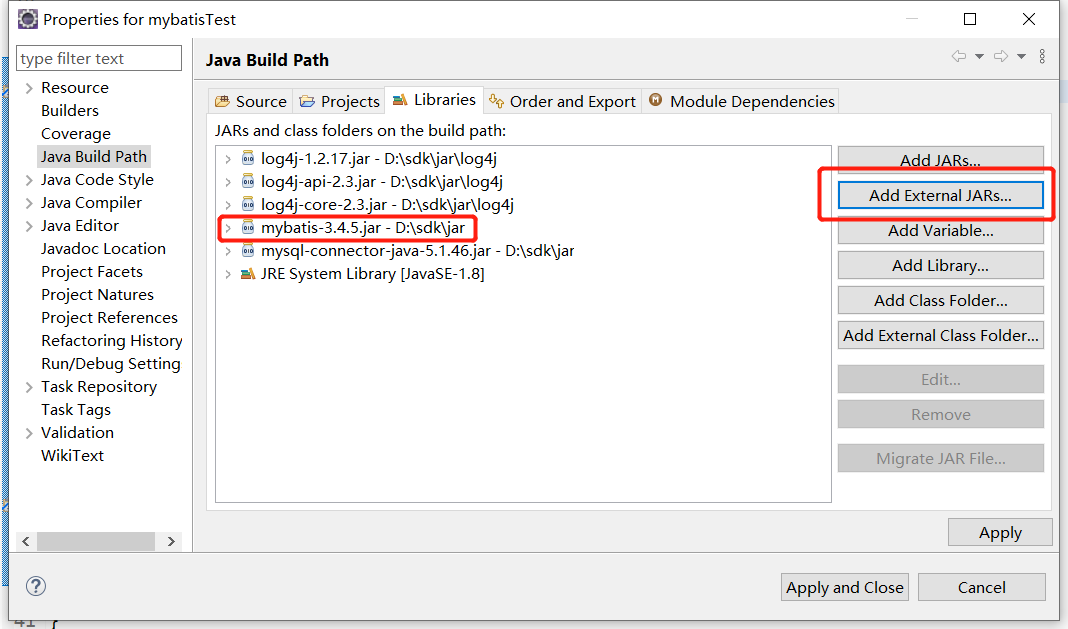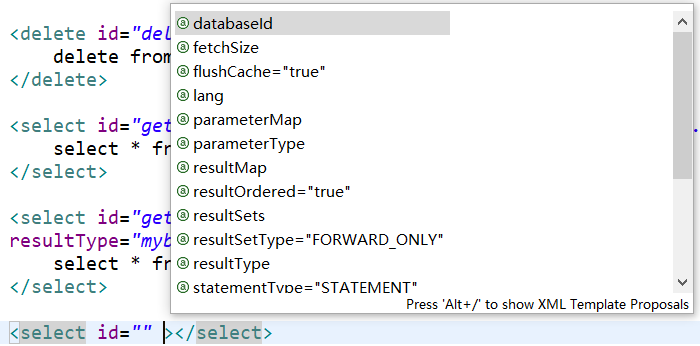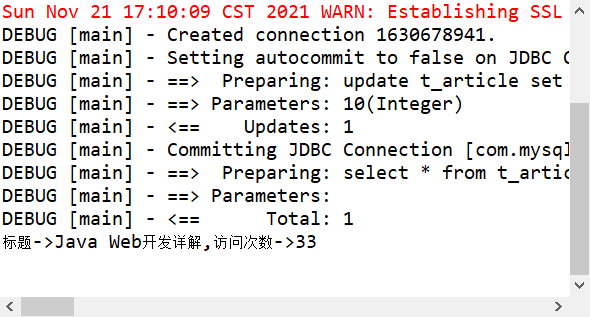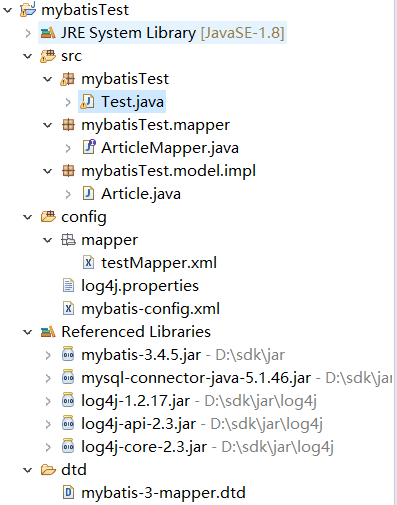快速上手MyBatis
相对于Hibernate,MyBatis是一个半自动化映射的数据库框架,它的前身是Apache的一个开源项目iBatis。Hibernate完全以面向对象编程的方式操作数据库(ORM),主要用在企业级应用开发领域,对于互联网应用开发中使用较少(主要是由于不够灵活,性能较差、SQL优化较难)。而对于原始的JDBC的方式,比较繁琐,容易造成重复的代码。MyBatis需要我们自己编写SQL,定义映射关系。虽然工作量有点大,但架构优雅,方便优化SQL,所以MyBatis在大多数Java Web项目中,是更灵活、更好的选择。
下面演示在eclipse for javaee的ide中使用MyBatis操作MySQL数据库。
一、下载MyBatis
首先需要下载这个框架的jar包以及dtd描述符文件(在编辑器中可以有自动提示)。在github上可以下载到,地址:https://github.com/mybatis/mybatis-3/releases。![]()
二、引用MyBatis
1. 新建一个java project,右键项目引用mybatis-3.5.7.jar,将mysql数据库驱动以及log4j等jar包也一并导入。
2. 项目中建立dtd文件夹,将mybatis-3-mapper.dtd描述符文件复制进去,这样我们写mybatis的配置信息时就会有自动提示的效果。

3. 创建MySQL数据库表结构语句
DROP TABLE IF EXISTS `t_article`; CREATE TABLE `t_article` ( `id` int(11) NOT NULL AUTO_INCREMENT, `title` varchar(80) CHARACTER SET utf8 COLLATE utf8_general_ci NOT NULL, `author` varchar(30) CHARACTER SET utf8 COLLATE utf8_general_ci NOT NULL, `sort` varchar(30) CHARACTER SET utf8 COLLATE utf8_general_ci NOT NULL, `time` datetime NULL DEFAULT '2017-09-18 00:00:00', `star` int(11) NULL DEFAULT 0, `comment` int(11) NULL DEFAULT 0, `visit` int(11) NULL DEFAULT 0, `content` text CHARACTER SET utf8 COLLATE utf8_general_ci NULL, PRIMARY KEY (`id`) USING BTREE ) ENGINE = InnoDB AUTO_INCREMENT = 11 CHARACTER SET = utf8 COLLATE = utf8_general_ci ROW_FORMAT = Dynamic;
上面的准备工作做好,就可以正式使用MyBatis了。
三、使用MyBatis
1. 项目根目录下,创建config文件夹。然后右键这个文件夹,build path->use as source folder,将其作为源代码文件夹。后续创建的文件夹和文件都在这个config文件夹下面。
2. config目录下,创建mybatis-config.xml配置文件,内容如下:
<?xml version="1.0" encoding="UTF-8"?> <!DOCTYPE configuration PUBLIC "-//mybatis.org//DTD Config 3.0//EN" "http://mybatis.org/dtd/mybatis-3-config.dtd"> <!-- XML配置文件包含对MyBatis系统的核心设置 --> <configuration> <!-- 指定MyBatis所用日志的具体实现 --> <settings> <setting name="logImpl" value="LOG4J"/> </settings> <environments default="development"> <environment id="development"> <transactionManager type="JDBC"> <!-- 事务管理器。JDBC由应用程序管理、MANAGED由应用服务器管理 --> </transactionManager> <dataSource type="POOLED"> <property name="driver" value="org.gjt.mm.mysql.Driver"/> <!-- 数据库驱动 --> <property name="url" value="jdbc:mysql://localhost:3306/test?characterEncoding=UTF-8"/> <!-- MySQL数据库地址 --> <property name="username" value="root"/> <!-- 数据库用户名 --> <property name="password" value="123456"/> <!-- 数据库密码 --> </dataSource> </environment> </environments> <mappers> <mapper resource="mapper/testMapper.xml"/> <!-- 映射文件路径 --> </mappers> </configuration>
这个文件定义了数据库连接信息,以及映射文件信息。后面主程序将通过这个文件来连接数据库、建立映射关系。
3. config目录下创建mapper包,在里面创建testMapper.xml文件,内容如下:
<?xml version="1.0" encoding="UTF-8" ?> <!DOCTYPE mapper PUBLIC "-//mybatis.org//DTD Mapper 3.0//EN" "http://mybatis.org/dtd/mybatis-3-mapper.dtd"> <mapper namespace="mybatisTest.mapper.ArticleMapper"> <insert id="insertArticle" parameterType="mybatisTest.model.impl.Article" useGeneratedKeys="true" keyProperty="id" > insert into t_article(title,author,sort,time,star,comment,visit,content) values(#{title},#{author},#{sort},#{time},#{star},#{comment},#{visit},#{content}) </insert> <update id="addArticleVisit" parameterType="java.lang.Integer"> update t_article set visit = visit+1 where id=#{id} </update> <delete id="deleteArticle"> delete from t_article </delete> <select id="getAllArticles" resultType="mybatisTest.model.impl.Article"> select * from t_article </select> <select id="getOneArticle" parameterType="java.lang.Integer" resultType="mybatisTest.model.impl.Article"> select * from t_article where id=#{id} </select> </mapper>
这里面我定义了很多SQL,后面会用到其中的两个。
4. 建立log4j.properties 日志配置文件,内容如下:
# Global logging configuration
#\u5728\u5f00\u53d1\u73af\u5883\u4e0b\u65e5\u5fd7\u7ea7\u522b\u8981\u8bbe\u7f6e\u6210DEBUG\uff0c\u751f\u4ea7\u73af\u5883\u8bbe\u7f6e\u6210info\u6216error
log4j.rootLogger=DEBUG, stdout
# Console output...
log4j.appender.stdout=org.apache.log4j.ConsoleAppender
log4j.appender.stdout.layout=org.apache.log4j.PatternLayout
log4j.appender.stdout.layout.ConversionPattern=%5p [%t] - %m%n
5. 在src目录下,建立实体Bean类(Article),我们放到xxx.model.impl包里
package mybatisTest.model.impl; import java.util.Date; public class Article { private int id; private String title; private String author; private String sort; private Date time; private int star; private String comment; private int visit; private String content; public Article() { super(); } public Article(int id, String title, String author, String sort, Date time, int star, String comment, int visit, String content) { super(); this.id = id; this.title = title; this.author = author; this.sort = sort; this.time = time; this.star = star; this.comment = comment; this.visit = visit; this.content = content; } @Override public String toString() { return "标题->"+getTitle()+",访问次数->"+getVisit(); } public int getId() { return id; } public void setId(int id) { this.id = id; } public String getTitle() { return title; } public void setTitle(String title) { this.title = title; } public String getAuthor() { return author; } public void setAuthor(String author) { this.author = author; } public String getSort() { return sort; } public void setSort(String sort) { this.sort = sort; } public Date getTime() { return time; } public void setTime(Date time) { this.time = time; } public int getStar() { return star; } public void setStar(int star) { this.star = star; } public String getComment() { return comment; } public void setComment(String comment) { this.comment = comment; } public int getVisit() { return visit; } public void setVisit(int visit) { this.visit = visit; } public String getContent() { return content; } public void setContent(String content) { this.content = content; } }
6. 建立映射接口
package mybatisTest.mapper; import java.util.List; import mybatisTest.model.impl.Article; public interface ArticleMapper { public boolean addArticleVisit(int id) throws Exception ; public List<Article> getAllArticles() throws Exception ; }
简单起见,我只演示了其中两个。
7. 主方法调用测试
package mybatisTest; import java.io.IOException; import java.io.InputStream; import java.util.List; import org.apache.ibatis.io.Resources; import org.apache.ibatis.session.SqlSession; import org.apache.ibatis.session.SqlSessionFactory; import org.apache.ibatis.session.SqlSessionFactoryBuilder; import mybatisTest.mapper.ArticleMapper; import mybatisTest.model.impl.Article; public class Test { public static void main(String[] args) { // TODO Auto-generated method stub try { InputStream is = Resources.getResourceAsStream("mybatis-config.xml"); SqlSessionFactory sqlSessionFactory = new SqlSessionFactoryBuilder().build(is); SqlSession session = sqlSessionFactory.openSession(); ArticleMapper articleMapper = session.getMapper(ArticleMapper.class); articleMapper.addArticleVisit(10); session.commit();//提交更新 List<Article> articles = articleMapper.getAllArticles(); for (int i = 0; i < articles.size(); i++) { System.out.println(articles.get(i)); } } catch (Exception e) { // TODO Auto-generated catch block e.printStackTrace(); } } }
至此项目代码部分就完成了,下面可以直接运行这个项目。
运行结果

项目结构:



 浙公网安备 33010602011771号
浙公网安备 33010602011771号